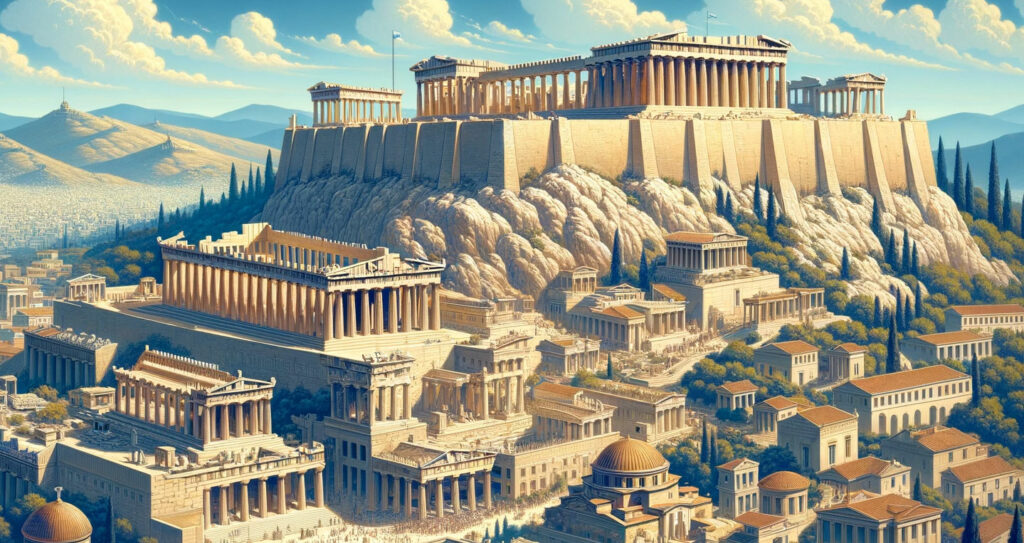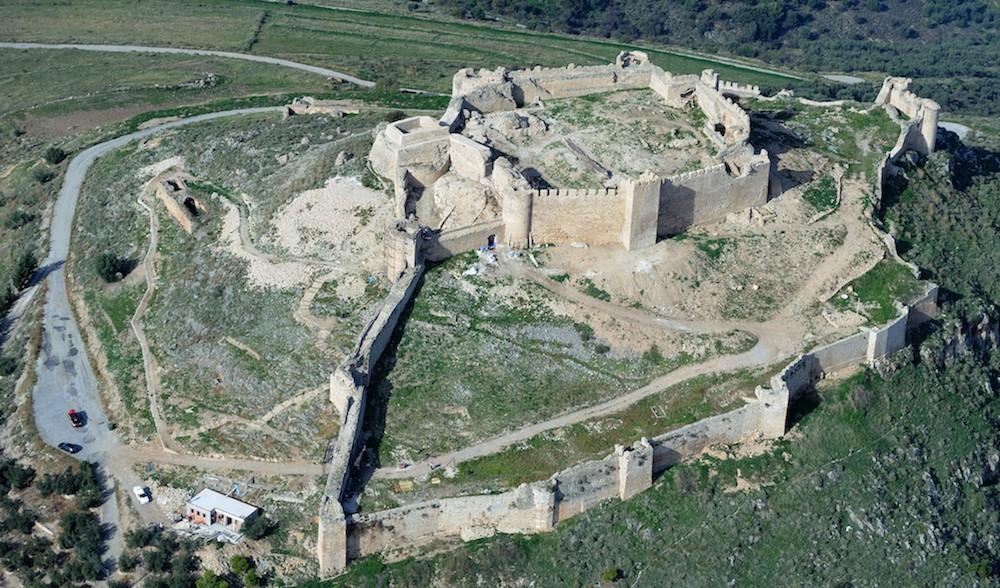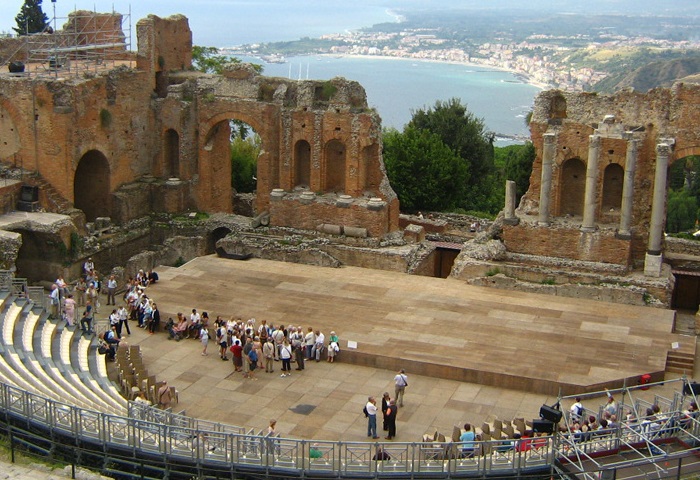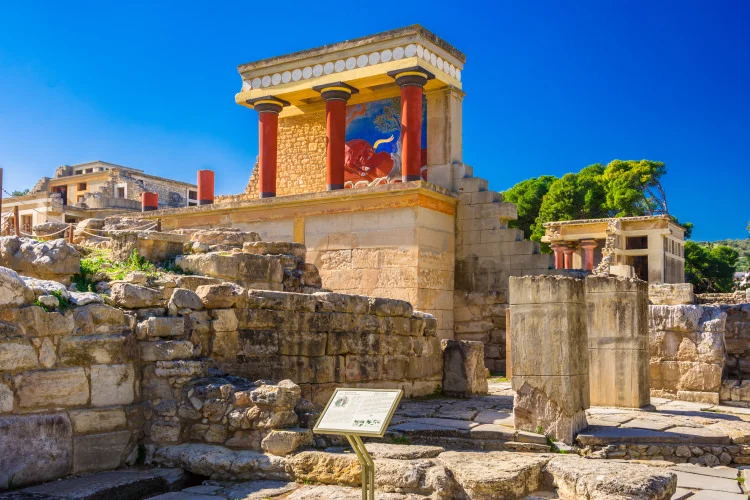Ancient Greece typically refers to a period that spans from around the 12th century BC to the end of antiquity (circa 600 AD).
The geographical landscape of Ancient Greece differed significantly from the Greece we know today. Some of what was Ancient Greece are now part of modern-day Turkey, and the neighboring countries have undergone changes over time.
Also, Ancient Greece wasn’t a unified nation but consisted of various self-governing city-states.
Within this timeframe, there are several significant eras, including the Archaic period (circa 800-500 BC), the Classical period (circa 500-323 BC), and the Hellenistic period (circa 323-31 BC), followed by Roman Greece.
However, the most commonly studied and renowned era of Ancient Greece is the Classical period, known for its dramatic advancements in philosophy, art, drama, and the early foundations of democratic government, especially in the 5th and 4th centuries BC.
Within this timeframe, there are several significant eras, including the Archaic period (circa 800-500 BC), the Classical period (circa 500-323 BC), and the Hellenistic period (circa 323-31 BC), followed by Roman Greece.
However, the most commonly studied and renowned era of Ancient Greece is the Classical period, known for its dramatic advancements in philosophy, art, drama, and the early foundations of democratic government, especially in the 5th and 4th centuries BC.
This guide, we hope, is your key to unlocking the secrets of Ancient Greek geography, a subject that tells the story of how people and places shape each other over time.
Where Exactly was Ancient Greece? Ancient Greece Geography – Discovering Its Location

Ancient Greece was pretty much in the same place geographically as Greece is now, with a few differences:
1 – Ancient Greece spilled over into what is now land that belongs to Turkey.
2 – In ancient times, Greece was bordered by Illyria to the northwest, Thrace to the north, and the expansive Persian Empire to the east. In contrast, contemporary Greece shares its borders with Albania to the northwest, the Republic of Macedonia to the north, Bulgaria to the northeast, and Turkey to the east.
3 – As just mentioned, Ancient Greece wasn’t one country. It was made up of self governing states.
Geographical Features of Ancient Greece
Ancient Greece was characterized by a diverse and rugged topography that played a significant role in the development of Greek societies.
Ancient Greek Regions
Geographically, it was divided into several regions, each with its own unique features and cultural identity.
The Peloponnese, a large and mountainous peninsula connected to the mainland by the narrow Isthmus of Corinth, was renowned for its powerful city-states like Sparta.
Central Greece was home to Athens, known for its philosophical and political contributions. while Northern Greece included regions like Macedonia, birthplace of Alexander the Great. The Greek archipelago comprised numerous islands, such as the Cyclades and Dodecanese, which were critical to trade and maritime prowess.
Thessaly (also known as Thessalia) was a significant region of ancient Greece, known for its unique geographical and cultural features. It was centrally located in the Greek mainland, surrounded by mountains that formed natural borders.
Ancient Greek Mountains
Mountains were a predominant feature of the Greek landscape, with roughly 80% of the country being mountainous, influencing city placement, agriculture, and local resources.
Mount Olympus stood as the tallest peak, not just in ancient times but also in modern Greece, its summit reaching 2,917 meters above sea level.
In ancient Greece, the primary mountainous backbone was the Pindus Mountain Range, which traversed from the north to the south across the majority of the Greek mainland.
Ancient Greek Seas
The surrounding seas — the Mediterranean, Aegean, and Ionian — were the lifeblood of Greek civilization, facilitating trade, cultural exchange, and military expeditions. The Aegean Sea, in particular, was dotted with over a thousand islands, extending the reach of Greek culture through extensive trade networks and colonies. These colonies stretched far beyond the Aegean, encompassing parts of what are now Italy, France, and even the coastlines of Africa, showcasing the breadth of ancient Greek influence.
Greek Islands
The ancient greeks own over 1000 islands in the waters around ancient Greece, mainly in the Aegean Sea but also in the Ionian Sea to the west of mainland Greece.
The islands offered a variety of advantages, including strategic locations for trade and military endeavors, as well as unique resources and agricultural prospects. The most well-known groups of islands included:
- The Cyclades: A group of islands in the central Aegean Sea, known for their distinctive Cycladic culture during the early Bronze Age and significant places like Delos, considered a sacred island and the mythological birthplace of Apollo and Artemis.
- The Dodecanese: Located in the southeastern Aegean, closer to Asia Minor, including the island of Rhodes, which was famous for its colossal statue, one of the Seven Wonders of the Ancient World.
- The North Aegean islands: Including Lemnos, Lesbos, and Chios, which were important centers of trade and culture.
- The Ionian Islands: To the west of the mainland, these islands, such as Corfu, had their own distinct historical trajectory and were later influenced by Roman and Venetian rule.
- Crete: The largest and most southern of the Greek islands, it was the center of the Minoan civilization, one of the earliest civilizations in Europe.
What Was the Climate like in Ancient Greece?
Back in Ancient Greek times, Greece was hot. Pretty much like it is now. They had long hot dry summers with mild and wet winters. Temperatures in the summer were anything between 25°C and 40°C.
What Animals and Crops Did Ancient Greece Have?
Ancient Greece’s diverse climates and landscapes supported a variety of crops and animals. The Greeks cultivated olives and grapes in abundance, which were essential to their diet and economy, along with grains like wheat and barley.
They also kept a range of domesticated animals including sheep, goats, pigs, and chickens, primarily for food and agricultural labor.
The seas around Greece teemed with fish, which was a significant part of the ancient Greek diet. Wild animals such as hares, deer, and boars were hunted for sport and food, while bees were kept for honey.
Cities in Ancient Greece
Ancient Greece was a wash with powerful cities, as most of the country was comprised city-states, known as “poleis.”
Each city-state was politically independent, with its own government, laws, customs, and money. Here are some of the most prominent ancient Greek cities:
Athens
Famous for its significant contributions to democracy, philosophy, theatre, and the arts. It was also a powerful navy during the Golden Age of Pericles. It was named after the greek goddess Athena. The name of the city comes from the Goddess Athena.

The city gave birth to some of the world’s most famous philosophers such as Plato, Aristotle and Socrates.
Sparta
Known for its military discipline and prowess, Sparta was one of the most iconic city-states of ancient Greece. Sparta had a unique society focused on producing the most fearsome warriors, which was very unique compared to other Greek states.

Following their victory over Athens in the Peloponnesian War, Sparta emerged as a preeminent power in the ancient Greek world.
Corinth: A major trade city, Corinth was known for its wealth and was a leader in Greek artistic and architectural developments during the Archaic period.
Thebes:

A powerful city-state, especially in the 4th century BC, Thebes was the birthplace of several notable figures, including the legendary hero Hercules.
Argos:

One of the oldest Greek cities, it was a significant religious center dedicated to the god Hera.
Miletus:

An important city in Ionia, on the western coast of Asia Minor, it was a center of philosophy and science.
Syracuse:

A powerful city-state on the eastern coast of Sicily, it was a center of Greek culture in the west.
Ephesus:

Known for the Temple of Artemis, one of the Seven Wonders of the Ancient World, it was an important city for both commerce and religion.
Rhodes:
Famous for the Colossus of Rhodes, another of the Seven Wonders, it was also significant in trade and as a naval power.

Olympia:

While not a city-state, Olympia was the site of the original Olympic Games and a major religious center dedicated to Zeus.
Delphi:

The site of the Oracle of Delphi, it was considered the center of the world by the ancient Greeks.
Knossos:

The largest Bronze Age archaeological site on Crete and has been called Europe’s oldest city, associated with the myth of the Minotaur in the labyrinth.
Fascinating Facts About Ancient Greece
- The Aegean sea contains more than 1000 islands.
- Crete is the largest of the Ancient Greek islands. It is located in the Mediterranean Sea at the southern edge of the Aegean Sea and has been an influential center of culture and commerce throughout history.
- The twelve Olympian deities, revered by the ancient Greeks, were believed to reside on the summit of Mount Olympus in the northern part of Greece. Throughout the ancient Greek territories, a multitude of sanctuaries were erected on elevated terrains, including the renowned Acropolis of Athens, to honor these gods.
- The Pindus Mountain Range, stretching across the Greek mainland, is often metaphorically described as “the spine of Greece” due to its central location and the way it extends down the country’s length, much like a backbone.